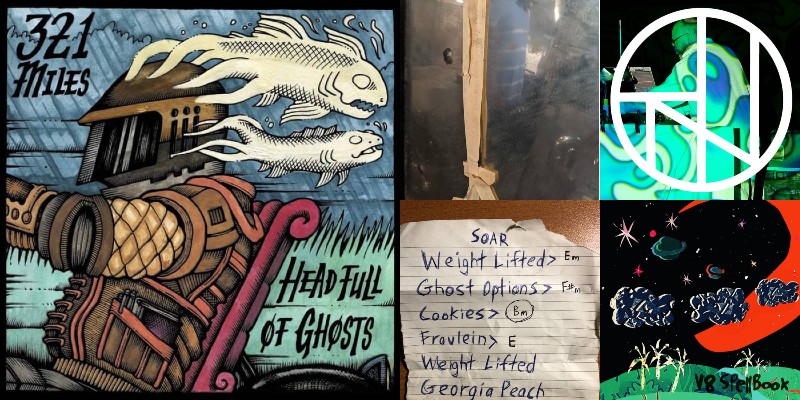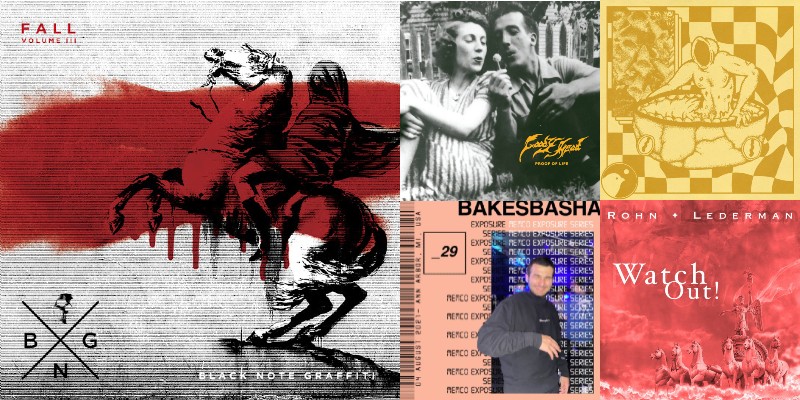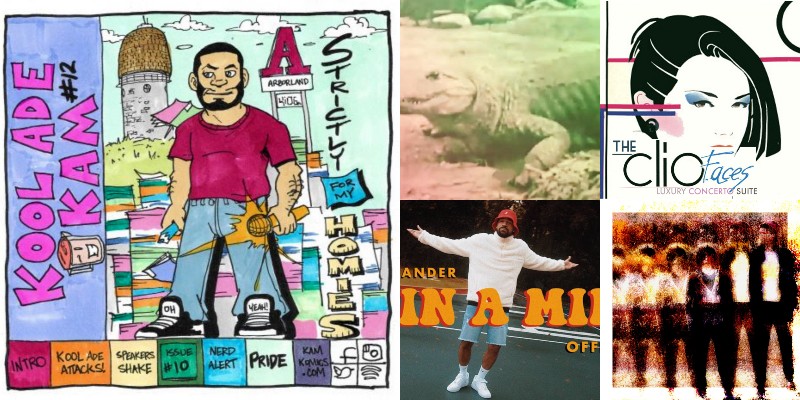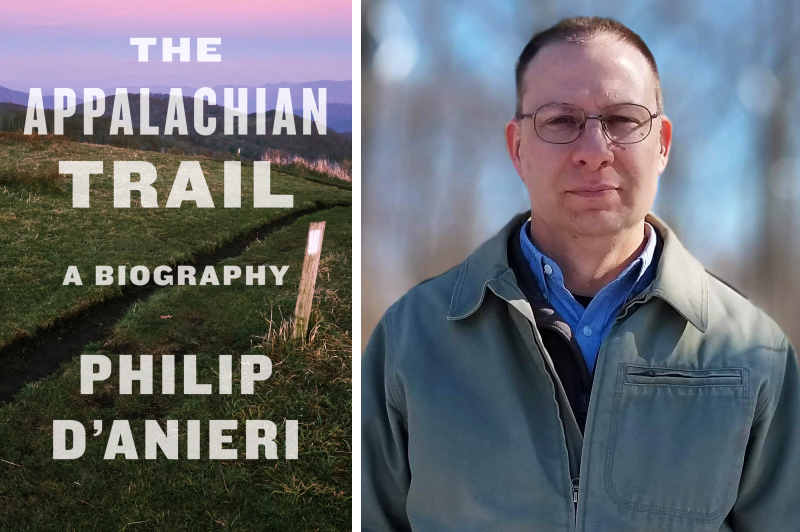UMMA's "Claim Your Space" campaign encourages people to find their place at the museum

Ostensibly, the "Claim Your Space" promo video was made to highlight the University of Michigan Museum of Art's extending its Thursday through Sunday hours starting Sept. 7 and a new effort to attract people to the building.
But the video isn't just an ad for UMMA; it's a work of art that stands by itself and shows off the immense creative talent of the U-M students who made it.
Kool Ade Kam aka Kam Komics aka Kamron Reynolds is a Washtenaw County Creative With Drive, Energy, and a whole lot of multifaceted talent

"It's your friendly neighborhood comic book artist and rapper, Kool Ade Kam," wrote Kamron Reynolds in an email that was as breezy and direct as his stylings on the mic.
I knew the Ann Arbor-raised, Ypsi-residing Reynolds' art via his DIY comic-book series Kam Komics and his cover illustration for fellow rapper Nickie P's recent EP, Collective Thought. But I had somehow missed Reynolds' own music until I discovered his new and joyous Strictly for My Homies mini-album on Bandcamp—his ninth release as a solo artist. That led me back to The Gostbustaz, his long-running hip-hop group, whose members include "Bredd Loaf, JU-C Juice, and Grandmaster Kas," Kam said. "Sometimes Ant the Champ is in the group too. I don’t really know what the future of the Gostbustaz is. I think for the Gostbustaz to happen again we’d all have to sit down and talk about it."
The Gostbustaz last released a slew of singles in 2016, including the absolute banger "Banned in Ann Arbor," which is based on a massive guitar riff.
Friday Five: Head Full of Ghosts, EnD, V8 Spellbook, Ma Baker, and Men Wearing Dresses

Friday Five highlights music by Washtenaw County-associated artists and labels.
This week features folk-grunge by Head Full of Ghosts, industrial electronics from EnD, avant hip-hop by V8 Spellbook, jams from Ma Baker, and I dunno what from Men Wearing Dresses.
Bill Edwards made the most of the pandemic era with an ambitious new album, "Whole Cloth"

Where some musicians may have understandably felt limited by the constraints of the COVID-19 pandemic, Ann Arbor singer-songwriter Bill Edwards took it as an opportunity.
Unable to collaborate with other musicians, Edwards decided to record full-band music all by himself—playing instruments both familiar and new, and learning software packages as well. He wrote, recorded, and started the process again, ultimately finding himself with 30 fully finished songs.
The resulting album, Whole Cloth, is a major achievement, filled with gems about chasing love, finding love, losing love, and more—and shifting among various musical subgenres that all fit under the broad umbrella of Americana, from old-time country to roots rock to western swing.
While nearly all the songs concern relationships in one way or another, “You’re Still Here” is a touching ode to a friend long gone, while “Ain’t Wet Yet” finds some humor in the politics of trickle-down economics and “Sing Me” praises the power of music itself.
Edwards, who was already skilled on multiple instruments, uses his versatile abilities to great effect throughout the album, such as a warm acoustic guitar solo on “Slow Down the Moon” and wistful fiddle on “Billy’s Lament.” The latter is one of three instrumentals on the album, crafted while Edwards had a paralyzed vocal cord— even that couldn’t slow down his creative process.
He's performing a free-admission album release concert on Aug. 27 with Lauren Crane opening the show.
"I’ll play a short selection of my favorite older songs, and then dig into the new record," Edwards said. "For the latter, since the arrangements rely heavily on drums and a variety of lead instruments, I’ll play acoustic guitar and sing to tracks from the album. I’ve got them recorded in my looper pedal, and it works quite well."
Edwards agreed to answer some questions about the new album.
Friday Five: Mark Kirschenmann, Estar Cohen, Isaac Levine, Rod Johnson, Mark Jewett

Friday Five highlights music by Washtenaw County-associated artists and labels.
This week features experimental trumpet by Mark Kirschenmann, jazz vocals by Estar Cohen, an indie-waltz by Isaac Levine, and Americana from Rod Johnson and Mark Jewett.
"Whip" It: Nadim Azzam's new YouTube show cruises with Michigan musicians

[This story was originally published on December 9, 2020. The entire first season is out now on YouTube and the show is having a concert at The Blind Pig on Saturday, September 11 featuring everyone who has appeared in the series so far: Dani Darling, Pariis Noel, D. Vaughn the Illest, Mirror Monster, KI5, and host Nadim Azzam.]
Artists performing songs being driven around in a car by a congenial host. Sound familiar?
But Whip Jams isn't Carpool Karaoke.
Host Nadim Azzam doesn't fuss around with wacky comedy. He gets right to the point with his guests, reciting a short bio, picking the musician up in his car, letting them perform, and concluding with a brief interview.
The first episode of this YouTube show clocks in at 4 minutes, 57 seconds. A quick ride indeed.
In the Whip Jams debut on December 9, Ann Arbor's Ki5 performs a song in Azzam's vehicle by sampling his voice with the Boss RC-505 Loopstation sitting in his lap. That kind of compact setup works fine for him, but some future episodes will feature artists holding acoustic instruments—might get a little cozy in Azzam's Honda Civic.
Friday Five: Grandmaster Masese, Otto Turtle & Friends, John Bunkley, Michael Malis, Disaster Relief

Friday Five highlights music by Washtenaw County-associated artists and labels.
This week features Kenyan music by Grandmaster Masese via Ann Arbor label Dagoretti Records, kids music from Otto & Friends, reggae-soul from John Bunkley, experimental piano by Michael Malis, and Afro-jazz-funk by Disaster Relief.
Friday Five: Black Note Graffiti, Goodyhead, Golden Feelings, Bakesbasha, Rohn - Lederman

Friday Five highlights music by Washtenaw County-associated artists and labels.
This week features alternative rock by Black Note Graffiti, shoegaze by Goodyhead, meditation music by Golden Feelings, a funky house mix by Bakesbasha, and dark electronic pop by Rohn - Lederman.
Friday Five: Kool Ade Kam, Mirror Monster, Jevon Alexander, G.B. Marian, Kawsaki

Friday Five highlights music by Washtenaw County-associated artists and labels.
This week features old-school hip-hop from Kool Ade Kam, beautifully balladry by Mirror Monster, a new rap video by Jevon Alexander, esoteric ambient via G.B. Marian, and a mega-mix by Kawsaki.
U-M Lecturer Philip D’Anieri's Book Maps the Appalachian Trail Through the Stories of Its Developers

The 2,000+-mile Appalachian Trail spans the eastern United States from Georgia to Maine, traversing 14 states in total. The trail looms large in the consciousness of many people, from sightseers to thru-hikers. But how did such a major trail get created?
U-M lecturer Philip D’Anieri shows how the Appalachian Trail could not exist without the significant effort and devotion of instrumental individuals over time in his new book, The Appalachian Trail: A Biography. He provides not only facts about the contributors’ lives but also insights into who they were and what motivated them to contribute to the AT. D’Anieri also examines how the AT forms and fits into our views of nature.
Each chapter outlines how a different person (or people) helped shape the trail’s establishment. The trail’s development occurred alongside the growth of the United States, causing conflict when the trail was at odds with roads, politics, or interests of private landowners. The story begins with Arnold Guyot’s mapping of the Appalachian Mountains, as published in an article in 1861. In subsequent years, various individuals explore and build miles of trail, from the librarian Horace Kephart to Benton McKaye’s coining of the name “Appalachian Trail” in the early 1900s.
The first thru-hikers, Earl Shaffer and Emma Gatewood in 1949 and 1955, respectively, influenced the use of the AT. Another chapter depicts Senator Gaylord Nelson, who introduced legislation to federally protect the trail in the 1960s and also founded Earth Day in 1970. The book goes on to describe the challenges and successes of the National Park Service, which sought to obtain land along the AT’s corridor. Bill Bryson’s bestseller, A Walk in the Woods published in 1998, drew many to the trail, as D’Anieri writes in the penultimate chapter.
At the start and end of the book, D’Anieri reflects on the Appalachian Trail’s meaning in the public consciousness and his own engagement with the trail. In the introduction, he writes:
The places we choose, and the way we then develop and manage them, tell us a lot about what we are asking from nature, what exactly we think we are traveling toward and escaping from, where we want to strike the balance between maddening civilization on the one hand, and heartless nature on the other.
This question sets the stage for studying various individuals’ involvement in the AT’s construction.
D’Anieri finishes the book by discussing his adventures in driving the length of the trail and hiking short sections. His points that the Appalachian Trail is for everyone, and that there is much value to walking rather than driving, offer a current take on the trail. There is a great opportunity to interact with nature via the AT, to step away from our existing lives for a different outlook.
I interviewed D’Anieri to learn more about his book and the process of writing it.


































